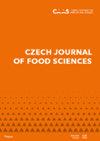Yogurt fortified with GABA-producing strain and Ganoderma lucidum industrial waste
IF 1
4区 农林科学
Q4 FOOD SCIENCE & TECHNOLOGY
引用次数: 3
Abstract
This study aimed to produce yogurt with Ganoderma lucidum residues and selected probiotic bacteria. To select the most potent GABA-producing strain (GABA – γ-aminobutyric acid), nine probiotic bacteria were subjected to the glutamate decarboxylase (GAD) activity assay. Limosilactobacillus reuteri DSM 17938 was selected and used in preparing fresh yogurts, with and without supplementation of Ganoderma residues obtained after water extraction [GW (Ganoderma waste) 2% (w/v)]. A decrease in pH during fermentation and the occurrence of syneresis were investigated. Lactic acid bacteria (LAB) viability and anti-Escherichia activity were estimated. Further, the cytotoxic effect of yogurt extracts on the human colon cancer cell line (HCT116) was surveyed. Besides functionality, the sensory attributes were evaluated. The pH values did not significantly change with the GW addition while increasing the LAB counts [up to 9.76 ± 0.11 log colony-forming units (CFU) mL–1] and the cytotoxic effect on HCT116 cells. Yogurt produced with selected bacteria and GW had the most valuable anti-coli effect against E. coli 0157: H7 and E. coli ATCC 35218 (American Type Culture Collection, Rockville, Maryland) (4.81 ± 0.62 and 5.64 ± 0.29 CFU mL–1, respectively). Although the added GW increased the yogurt functionality, it had a slightly negative effect on the taste and texture of the partially modified recipe. Yogurts fortified with GABA-producing strain and GW could potentially reduce relapse rates of depressive disorders.用产gaba菌株和灵芝工业废料强化酸奶
本研究旨在利用灵芝残渣和选定的益生菌生产酸奶。为了选择最有效的GABA产生菌株(GABA-γ-氨基丁酸),对9种益生菌进行谷氨酸脱羧酶(GAD)活性测定。选择路氏利莫西乳酸杆菌DSM 17938并用于制备新鲜酸奶,添加和不添加水提取后获得的灵芝残留物[GW(灵芝废物)2%(w/v)]。研究了发酵过程中pH值的降低和脱水的发生。对乳酸菌(LAB)活力和抗大肠杆菌活性进行了评估。此外,研究了酸奶提取物对人结肠癌癌症细胞系(HCT116)的细胞毒性作用。除了功能外,还对感官属性进行了评估。在增加LAB计数[高达9.76±0.11对数集落形成单位(CFU)mL–1]和对HCT116细胞的细胞毒性作用的同时,pH值没有随着GW的添加而显著变化。用选定的细菌和GW生产的酸奶对大肠杆菌0157:H7和大肠杆菌ATCC 35218(美国典型培养物保藏中心,马里兰州罗克维尔)具有最有价值的抗大肠杆菌作用(分别为4.81±0.62和5.64±0.29 CFU mL–1)。尽管添加的GW增加了酸奶的功能,但它对部分修改后的配方的味道和质地有轻微的负面影响。富含GABA产生菌株和GW的酸奶可能降低抑郁障碍的复发率。
本文章由计算机程序翻译,如有差异,请以英文原文为准。
求助全文
约1分钟内获得全文
求助全文
来源期刊

Czech Journal of Food Sciences
Food Science & Technology, Chemistry-食品科技
CiteScore
2.60
自引率
0.00%
发文量
48
审稿时长
7 months
期刊介绍:
Original research, critical review articles, and short communications dealing with food technology and processing (including food biochemistry, mikrobiology, analyse, engineering, nutrition and economy). Papers are published in English.
 求助内容:
求助内容: 应助结果提醒方式:
应助结果提醒方式:


